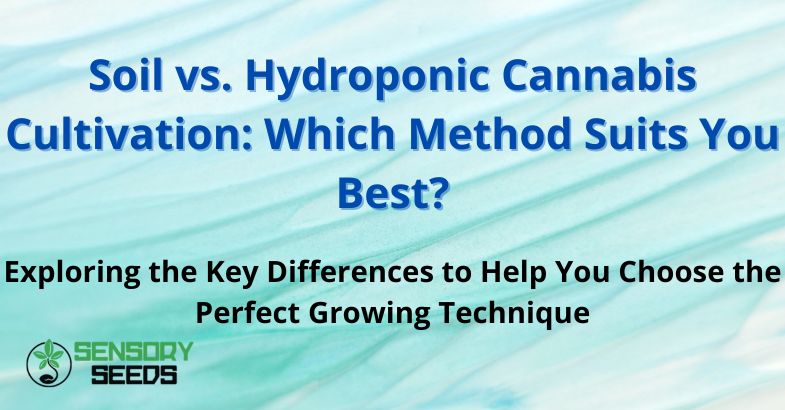Published on: 13/12/2024
Exploring the Key Differences to Help You Choose the Perfect Growing Technique
Two of the most common and often compared practices in cannabis seeds cultivation are growing in soil and growing hydroponically. Both methods have their advantages and disadvantages, and the choice between them depends on several factors, such as available space, resources, and the grower’s level of experience.
In this article, we’ll dive deep into the benefits and challenges of growing cannabis in soil versus hydroponics, providing insights to help you decide which method aligns best with your space, resources, and experience level.
What is Soil Cultivation?
Soil cultivation is the traditional and most natural method for growing plants, including cannabis. Soil is not just a physical substrate; it’s a complex ecosystem that provides nutrients, water, and physical support to the plant. It contains organic and inorganic nutrients, microorganisms, and decomposing organic matter, all of which contribute to supplying the plant with essential elements for growth.
While it may seem simple, soil cultivation can be affected by many external factors, such as pH, drainage, nutrient presence, and soil density. Good soil for cannabis cultivation must be rich, well-aerated, capable of retaining water while also providing good drainage to prevent root rot.
Read also: Sowing without soil? How is it possible?
Advantages of soil cultivation:
- Easier for beginners: soil cultivation is less technical compared to other methods, as it requires less specific knowledge about plant feeding. The soil itself contains a reserve of nutrients that can sustain the plants.
- Better flavor: many growers claim that cannabis grown in soil has a better taste. This is due to the presence of organic substances and microbes that can enhance the plant’s aromatic profile.
- Less frequent monitoring: once properly prepared, soil can provide a stable base for the plant, requiring fewer daily checks.


Disadvantages of soil cultivation:
- Slower growth: plants grown in soil tend to grow more slowly than those grown hydroponically. This is due to the lower immediate availability of nutrients.
- Pest and disease issues: soil can be a breeding ground for fungi, bacteria, insects, and other pests that can harm the plants.
- Less precise control: while soil contains nutrients, it’s hard to know exactly what’s present in sufficient quantities and what’s lacking, making it more difficult to address deficiencies or excesses.
What is Hydroponic Cultivation?
Hydroponic cultivation is a technique that does not use soil but instead relies on nutrient solutions delivered directly to the plant’s roots. Plants are typically grown in an inert substrate like expanded clay, perlite, rock wool, or coconut fiber. The main goal of hydroponics is to provide the plants with immediate access to the nutrients they need, eliminating the need for the plant to “search” for these nutrients in the soil.
This system is highly efficient and allows plants to grow much faster than they would in soil. However, it requires a larger initial investment and greater technical expertise, as nutrient control, pH, and root oxygenation are critical.
Advantages of hydroponic cultivation:
- Faster growth: since nutrients are immediately available to the roots, plants don’t need to expend energy searching for them, accelerating the growth process.
- Higher yields: hydroponic crops tend to produce higher yields than soil-based crops, as plants can grow faster and more vigorously.
- Better control: growers have complete control over nutrients, pH, and environmental conditions, allowing them to fine-tune everything to maximize plant growth.
- Fewer pests and diseases: without soil, there is a significantly reduced risk of soil-borne diseases and pests.
Disadvantages of hydroponic cultivation:
- Initial cost: hydroponic systems require a higher initial investment than soil cultivation, both for purchasing equipment and maintaining it.
- More attention and monitoring: hydroponics requires constant control of various factors, such as pH, nutrients, and oxygen in the roots. A small mistake in any of these areas can severely compromise plant growth.
- Less room for error: in hydroponic cultivation, if something goes wrong with the nutrient solution or system, plants can suffer much more quickly than those grown in soil, which have a reserve of nutrients to draw from.
Key Differences between Hydroponic and Soil Cultivation
To determine which method might be best for your needs, it’s essential to examine the key differences between soil and hydroponic cultivation in terms of growth time, yield, product quality, and required resources.
-
- Growth and yield: as mentioned earlier, plant growth is generally faster in hydroponics. This is because, in a hydroponic system, nutrients are delivered directly to the roots in a readily absorbable form, allowing the plant to use less energy searching for nourishment and focus on growth. Soil, on the other hand, acts as a natural filter, retaining some nutrients that may not be immediately available to the plants. An experienced hydroponic grower can achieve more frequent and abundant harvests than a soil-based grower, especially in controlled environments such as grow rooms or greenhouses. However, higher hydroponic yields are not guaranteed; they depend on the grower’s skill level and ability to maintain optimal environmental and nutritional conditions.


- Product quality: the quality of the final product is one of the most debated aspects between soil and hydroponic cultivation enthusiasts. Many organic growers argue that soil-grown cannabis has a richer, more complex aroma and flavor, thanks to the presence of microorganisms in the soil that promote the production of terpenes and other aromatic compounds. However, high-level hydroponic growers can achieve equally high-quality plants, provided they have a good understanding of how to regulate nutrients and growing conditions.
- Cost and maintenance: another significant difference between the two methods is cost and maintenance. Soil cultivation is generally cheaper to start, requiring fewer specialized tools and a more intuitive approach. However, hydroponic cultivation can be expensive, especially at the outset, as it requires pumps, tanks, nutrient solutions, and monitoring systems. Moreover, hydroponic systems must be carefully maintained and cleaned to prevent salt buildup and the growth of algae or mold, while soil, if properly managed, may require less attention.
- Environmental sustainability: from a sustainability perspective, both techniques have their pros and cons. Hydroponics uses less water than soil cultivation, as the system recycles the nutrient solution. However, hydroponics requires energy to power pumps and other devices, which could increase the ecological footprint, especially if renewable energy sources aren’t used. On the other hand, soil cultivation may be more natural, but it requires more water, and the soil itself can become depleted if not properly managed or regenerated.
Read also: Growing cannabis outdoors: what it means + pros and cons
Which technique is best for you?
Choosing between soil and hydroponic cultivation largely depends on your specific needs, experience level, and available resources. If you’re a beginner grower or looking for a more natural method, soil may be the right choice for you. On the other hand, if you have the necessary experience and are looking for higher yields and precise control over nutrients and growing conditions, hydroponics could offer you the best results.
Both methods have the potential to produce high-quality cannabis, and many experienced growers use a combination of both techniques to maximize the advantages of each.
Conclusion
In conclusion, both hydroponic and soil-based cannabis cultivation are highly valid techniques with very different characteristics. While soil cultivation offers a more traditional and straightforward method, hydroponics provides advanced control that can lead to higher yields and faster growth. However, each method comes with its own set of challenges, and the final choice depends on your priorities and expertise. Having a deep understanding of both techniques will allow you to make the best decision to optimize your cannabis cultivation.
Ready to start your own cannabis cultivation journey? Visit SensorySeeds, the leading online store for premium cannabis seeds. Whether you’re growing hydroponically or in soil, SensorySeeds has a wide selection of top-quality strains to help you succeed. Shop now and discover the best seeds for your next cultivation project!









